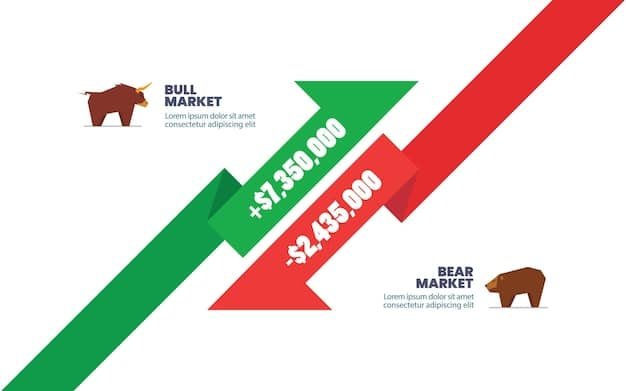Tax Loss Harvesting: Your Guide to Lowering 2025 Taxes

Tax loss harvesting is a strategy used to reduce your tax bill by selling investments at a loss to offset capital gains, potentially lowering your 2025 tax liability by strategically managing your portfolio.
Navigating the complexities of investment taxes can be daunting. However, with savvy strategies like tax loss harvesting, you can potentially reduce your tax burden and optimize your investment returns for 2025.
Understanding Tax Loss Harvesting
Tax loss harvesting is a powerful technique that allows investors to strategically sell assets at a loss to offset capital gains. This can significantly reduce your overall tax liability. But what exactly does it involve, and how can you implement it effectively?
The Basics of Capital Gains and Losses
Before diving into tax loss harvesting, it’s crucial to grasp the concepts of capital gains and losses. A capital gain occurs when you sell an asset for more than you bought it for, while a capital loss happens when you sell an asset for less. Both have tax implications that can be strategically managed.
How Tax Loss Harvesting Works
Tax loss harvesting involves selling investments that have declined in value to realize a capital loss. These losses can then be used to offset capital gains, reducing your taxable income. Any excess losses can often be carried forward to future tax years.
- 📉 Realize losses by selling underperforming investments.
- ⚖️ Offset capital gains with these realized losses.
- Carry forward any excess losses to future tax years.
By understanding these fundamental elements, you can start to see how tax loss harvesting can be a vital part of your tax planning strategy, helping to minimize your tax bill and potentially improve your overall financial performance without incurring significant penalties.
Benefits of Tax Loss Harvesting for 2025
The advantages of tax loss harvestingextend beyond just reducing your immediate tax bill. When done right, this strategic move can have far-reaching positive effects on your investment portfolio and long-term financial health.
Lowering Your Tax Liability
The primary benefit is, of course, reducing your current tax liability. By offsetting capital gains with losses, you minimize the amount of taxes you owe, freeing up capital that can be reinvested or used for other financial goals.
Improving Portfolio Performance
Reinvesting the tax savings back into your portfolio can boost your overall returns. This can lead to better long-term growth and help you reach your financial objectives faster.

Managing Risk Efficiently
Tax loss harvesting allows you to rebalance your portfolio while minimizing tax consequences. You can sell underperforming assets and reinvest in more promising opportunities without triggering a large tax bill.
Understanding these benefits, you can see how carefully using loss tax loss harvesting can be a smart move to grow wealth and minimize tax liabilities, thus enhancing your long-term financial well-being.
Potential Risks and Limitations
While tax loss harvesting offers significant benefits, it’s important to be aware of the potential risks and limitations. Knowing these pitfalls can help you navigate the strategy more effectively and avoid unintended consequences, making better, more informed financial decisions.
The Wash-Sale Rule
The wash-sale rule is a critical consideration. It prevents you from repurchasing the same or a substantially similar investment within 30 days before or after the sale. Violating this rule can disallow the tax loss, negating the benefits of tax loss harvesting.
Transaction Costs
Frequent trading to harvest losses can incur transaction costs, such as brokerage fees. These costs can eat into the tax savings, making the strategy less effective, especially for smaller portfolios.

Complexity
Implementing tax loss harvesting can be complex, requiring careful tracking of investments and tax implications. It may be beneficial to seek guidance from a tax professional to ensure compliance and maximize benefits.
Being aware of these risks and limitations allows you to approach tax loss harvesting with a balanced perspective, ensuring that you leverage its benefits responsibly and avoid potential pitfalls, promoting both tax efficiency and sound investment management.
Strategies for Effective Tax Loss Harvesting
To maximize the benefits of tax loss harvesting, it’s essential to employ effective strategies that align with your investment goals and risk tolerance. These strategies can help you navigate the complexities of the market and optimize your tax savings.
Diversifying Your Portfolio
A well-diversified portfolio provides more opportunities for tax loss harvesting. With a range of assets, you’re more likely to have some investments that have declined in value and can be strategically sold.
Using ETFs and Mutual Funds
ETFs (Exchange Traded Funds) and mutual funds offer easy ways to implement tax loss harvesting. You can sell one fund and invest in a similar but not substantially identical fund to maintain your asset allocation while realizing a tax loss.
Timing Your Trades
Consider the timing of your trades carefully. Tax laws and market conditions can change, so it’s important to stay informed and make decisions based on the current environment.
- 🕰️ Plan your trades around tax law changes.
- 📊 Monitor market conditions for optimal selling points.
- 🔄 Reinvest strategically to maintain your asset allocation.
With these strategies in mind, you’ll be well-equipped to implement tax loss harvesting in a way that enhances your tax efficiency while aligning with your broader investment strategy.
Tax Loss Harvesting and Your 2025 Taxes
As you prepare for your 2025 taxes, incorporating tax loss harvesting into your financial planning can be a strategic advantage. Understanding how past and current losses impact your tax liability is key to optimizing your financial outcome.
Reviewing Your Investment Performance
Start by reviewing your investment performance throughout 2024. Identify any assets that have declined in value and may be suitable for tax loss harvesting before the end of the year.
Calculating Capital Gains and Losses
Calculate your realized capital gains and losses to determine the net impact on your taxable income. This will help you understand how much you can potentially offset through tax loss harvesting.
Documenting Your Transactions
Keep meticulous records of all your trades, including the purchase and sale dates, prices, and any associated fees. This documentation is essential for accurately reporting your capital gains and losses on your tax return.
By taking these actions, you can effectively integrate tax loss harvesting into your 2025 tax strategy, maximizing your tax savings and ensuring compliance with tax regulations.
Seeking Professional Advice
Given the complexities of tax loss harvesting and its potential impact on your financial situation, seeking professional advice can be invaluable. A qualified financial advisor or tax professional can provide personalized guidance tailored to your specific circumstances.
Benefits of Professional Guidance
A professional can help you navigate the intricacies of tax laws, avoid common pitfalls like the wash-sale rule, and develop a strategy that aligns with your financial goals. They can also provide ongoing support and adjustments as your situation evolves.
Don’t hesitate to consult with a financial expert to ensure you’re making informed decisions and maximizing the benefits of loss harvesting while prudently managing your finances.
| Key Point | Brief Description |
|---|---|
| 📉 Reduce Tax Liability | Offset capital gains by selling losing investments. |
| 🔄 Avoid Wash-Sale Rule | Don’t repurchase similar assets within 30 days. |
| ⚖️ Seek Professional Advice | Ensure compliance and optimize strategu with expert help. |
Frequently Asked Questions
▼
The primary goal is to reduce your overall tax liability by offsetting capital gains with realized losses from selling underperforming investments, potentially reducing your taxes for the current year and future years.
▼
The wash-sale rule disallows a tax loss if you repurchase the same or substantially similar investment within 30 days before or after the sale. This prevents investors from generating artificial tax losses.
▼
Yes, if your capital losses exceed your capital gains, you can typically deduct up to $3,000 of the excess loss from your ordinary income. Any remaining losses can be carried forward to future tax years.
▼
Tax loss harvesting can benefit many investors, but it’s not a one-size-fits-all strategy. It’s most effective for those with taxable investment accounts and significant capital gains. Consulting a financial advisor can help determine if it’s right for you.
▼
The main risks include violating the wash-sale rule, incurring transaction costs from frequent trading, and the complexity of tracking investments and tax implications. Professional advice can help mitigate these risks.
Conclusion
Tax loss harvesting is a valuable strategy for reducing your tax liability and optimizing your investment returns. By understanding the principles and implementing effective techniques, you can potentially save money on your taxes and improve your overall financial health for 2025 and beyond. However, it’s wise to consult with a financial advisor to ensure the strategy aligns with your unique financial situation and goals.





